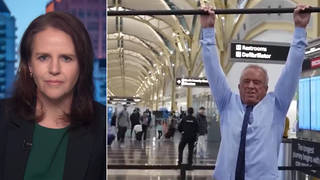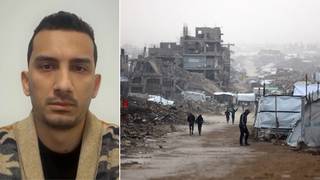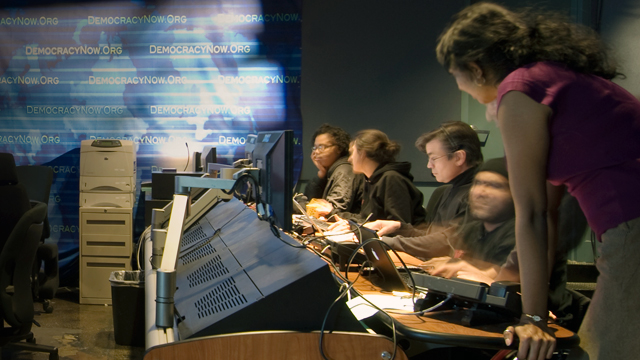
Topics
Guests
- Davide Piscitelliadvanced researcher at Forensic Architecture at Goldsmiths, University of London.
- Alex de Waalauthor and executive director of the World Peace Foundation at Tufts University.
The starvation crisis in Gaza is deepening under Israel’s brutal blockade and amid regular massacres of civilians attempting to secure aid at the only officially sanctioned aid sites, run by Israeli troops and American mercenaries. The so-called Gaza Humanitarian Foundation and the onset of famine are the subjects of a new report by analysts Davide Piscitelli and Alex de Waal for the research organization Forensic Architecture on the “architecture of genocidal starvation” in Gaza. “I’ve been working on this field of famine, food crisis and humanitarian action for more than 40 years, and there is no case, over those four decades, of such minutely engineered, closely monitored, precisely designed mass starvation of a population as is happening in Gaza today,” says de Waal, who is also the author of Mass Starvation: The History and Future of Famine.
Transcript
AMY GOODMAN: In one of the deadliest days yet for aid seekers in Gaza, Israeli forces killed at least 115 people on Sunday, including 92 who were killed while seeking aid. In the deadliest attack, at least 79 people at the Zikim crossing in North Gaza were massacred as they gathered near an aid convoy sent by the U.N. World Food Programme in northern Gaza in the hopes of getting flour. In a statement, the U.N. agency said, quote, “As the convoy approached, the surrounding crowd came under fire from Israeli tanks, snipers and other gunfire,” unquote.
These latest killings come as the starvation crisis in Gaza continues to deepen. UNRWA, the U.N. agency for Palestinian refugees, has accused Israel of starving civilians, including a million children. The entire population, more than 2 million people, lack access to sufficient food, putting their lives at immediate risk. Health authorities in Gaza say 19 people died of starvation over the last day, including at least one infant. This is the uncle of 3-month-old Yahya Al-Najjar.
ANAN AL-NAJJAR: [translated] He died due to malnutrition and the unavailability of baby formula at the Gaza Strip. We urge the entire world, all Arab countries and everyone with a living consciousness, humanity and dignity, to just stand with the children, just to let baby formula get into the Gaza Strip.
AMY GOODMAN: Since late May, when militarized aid sites run by the U.S.- and Israeli-backed so-called Gaza Humanitarian Foundation were established, nearly 900 Palestinians have been killed while attempting to access aid, and more than 5,700 have been injured. This is the brother of Raed Sindy, who was killed by Israeli fire while attempting to access aid yesterday at a site run by the U.S.-backed Gaza Humanitarian Aid Foundation.
AHMED SINDY: [translated] They go out just trying to stave off their hunger and the hunger of their children, but they come back wrapped in shrouds. We ask God Almighty, and we appeal to the international community, that these death traps be shut down and that humanitarian corridors be opened, out of mercy for our children, our women and our elderly.
AMY GOODMAN: For more, we’re joined by two guests. In London, Davide Piscitelli is with us, an advanced researcher at Forensic Architecture at Goldsmiths, University of London, where he co-directs Gaza research and is working on a forthcoming report tentatively titled “The Architecture of Genocidal Starvation in Gaza.” And in Somerville, Massachusetts, Alex de Waal is with us, executive director of the World Peace Foundation at Tufts University, author of the book Mass Starvation: The History and Future of Famine. He’s working with Forensic Architecture on their report on starvation in Gaza.
Welcome you both to Democracy Now! Davide Piscitelli, let’s begin with you. You are coming out with this final report in the next few weeks, but you felt it was critical to get out something faster than that. Talk about why and what you found.
DAVIDE PISCITELLI: Yeah, thank you.
What we saw yesterday, with over 90 people being killed while seeking aid, is something that we have been seeing daily since the end of May, especially with the introduction of the new Gaza Humanitarian Foundation aid system and also the dismantling of the U.N. system already in place, forcing civilians waiting aid at the crossing, like yesterday at the Zikim crossing in the north.
In our forthcoming report, we are analyzing how the militarized aid system, the GHF, is replacing the U.N. system in Gaza. The GHF is where we see most of the violence right now, especially in the proximity of the GHF, but also inside the GHF and along the path. And there is a reason for this. The GHF system has only like four stations. As we know, three are in Rafah, south of Gaza. One is in central, close to the Wadi Gaza. And this is only for the population that are in the south. So, the population that are in the north, they are completely cut out of this system. And we are comparing four stations to the 400 sites of the U.N. model.
So, we have been collecting and verifying visual evidence of attacks against civilians and infrastructure, again, both in the proximity of the GHF or inside them. And we also analyze the temporal and spatial architecture of the GHF system, which is a system that is designed to be little. So, what we saw yesterday and the day before and in the past month is just the result of this new, introduced militarized system. I can speak a bit more about the spatial and temporal architecture of the system, if you like.
AMY GOODMAN: Go ahead.
DAVIDE PISCITELLI: So, the GHF system, we are analyzing in two elements. Like, the spatial element, we call it a militarized system, because over the past 21 months we were analyzing satellite images, and we see how — we saw a lot of destruction. As we all know, virtually all Gaza has been destroyed. But in the meantime, there is a military infrastructure that is growing inside Gaza, starting from the margin, especially over the month of April and May 2025. We saw the complete destruction of Rafah and the construction of the corridor, the Morag Corridor. So, between the Morag Corridor and the Philadelphi Corridor, we start to see pop up new military stations. And few days after, we started to see what is today the aid distribution center of the GHF starting to grow out of this infrastructure. So the GHF aid system is an extension of the military infrastructure that Israelis put in place in Gaza.
And then there’s a temporal element of it. We analyzed over 160 announcements of the GHF. And by putting them on a timeline, we started to see that, on average, the site is only open for 20 to 23 minutes. And after the 19th of June, the site is only open for 10 minutes. That means that the civilians has only 10 minutes to enter and collect food, when it’s possible. Another important date on the time is the time between the announcement and the opening. And this shrank down to 17 minutes. Having only 17 minutes means two things: one, that Palestinians cannot access to the site, because they have to walk between 2.5 to 10 kilometers, by walk, under hot temperature, hot surfaces like sand and between rubble, but also it means that it forces further displacement towards the south. And we are seeing from satellite images that new tents are getting closer and closer to the GHF, but the GHF stations are inside the military zone, and this is where the shootings are happening right now.
AMY GOODMAN: Alex de Waal, I’d like to bring you into this conversation. You’re executive director of the World Peace Foundation at Tufts University, author of Mass Starvation: The History and Future of Famine. You’re working with Forensic Architecture on their report. We have just heard that in the last day 19 people, including at least one infant, have died of starvation in Gaza. Can you talk about why this is happening?
ALEX DE WAAL: So, let me say that I’ve been working on this field of famine, food crisis and humanitarian action for more than 40 years, and there is no case, over those four decades, of such minutely engineered, closely monitored, precisely designed mass starvation of a population as is happening in Gaza today.
So, we have known, from expert reports by the United Nations, by the independent Famine Review Committee, by many others, exactly how this situation would unfold. And in May, there were some authoritative reports that indicated two trajectories that starvation might take in Gaza. There was then a complete siege. And if that siege were to be continued, Gaza would completely run out of food within weeks. And it takes about 60 to 80 days for an adult to die of starvation. It’s entirely predictable, foreseeable. A child will die much more quickly, and particularly a young child without infant formula, without clean water, without maternal care, etc. We knew this was going to happen.
The Gaza Humanitarian Foundation has “humanitarian” in the name, but it is not anything that a humanitarian professional would ever design. There are decades of experience of how you design these operations to work in war zones, and the U.N. had had a system, 400 feeding stations, as Davide mentioned, all embedded within the community, so that you could use the support of the community, of families, to make sure there was minimal disruption. It wasn’t enough, but it was still something.
Now what is happening with the Gaza Humanitarian Foundation is that not enough food is being provided. It’s simply the rations are not enough. The essential food that children need is not there. The essential services, like clean water, like sanitation, like shelter, like fuel for cooking, none of those are there. And then, as this report documents, the only way in which people can get access to those centers is by putting themselves in harm’s way, by risking death by shooting, in order to get — to try and get food to feed their children.
So, it is entirely unsurprising, exactly as was predicted. And the only surmise that one — the only conclusion that one can come to is that Israel is doing this deliberately. They know exactly what they are doing, and this is intended.
AMY GOODMAN: Alex, you’ve referred to the ICJ — that’s the International Court of Justice — provisional order, more than a year ago, in March of 2024, that instructed Israel to provide a full spectrum of humanitarian relief and essential services through the U.N. Even the Israeli judge voted for it on the panel. It was unanimous. What happened as a result?
ALEX DE WAAL: So, that was a very, very important decision. It was an instruction, an order by the highest court in the world, the World Court, if you like, to Israel. And it had that humanitarian provision. It also had a vote of 16 to 1 to say that this was a requirement, if Israel were to fulfill its obligations to prevent genocide. Now, that is very important. The Genocide Convention is not a convention just for punishing genocide. It’s a convention for preventing it. So, by definition, you can’t wait until after a genocide has happened or after a famine has happened. We shouldn’t wait and then count the graves of the children who have died, and then say, “Wasn’t that terrible? Never again.” When we have an authoritative warning, we need to act — and not just Israel. All states that are signatory to the Genocide Convention — the United States, Germany, the United Kingdom — everyone is required to act to prevent genocide.
And that decision, that instruction, that order by the International Court of Justice — and, as you say, the Israeli former chair of the high court, Aharon Barak, voted for it — was the most authoritative order that one can have. And it has not been acted upon. And what is happening today with this Gaza Humanitarian Foundation is an utter travesty of that. And I think we can all draw the logical conclusion from this shameful failure to prevent an utterly foreseeable disaster and crime.
AMY GOODMAN: Well, I want to thank you both for being with us, and we’ll link to your reports, your preliminary findings at democracynow.org, and also, again, Alex, your London Review of Books article that we interviewed you for in May, called “Starvation in Gaza.” Alex de Waal, executive director of World Peace Foundation at Tufts University, author of Mass Starvation: The History and Future of Famine, he’s working with Forensic Architecture on their forthcoming report on starvation in Gaza, and Davide Piscitelli, speaking to you in London, advanced researcher for Forensic Architecture.
When we come back, we’ll look at a new 972 report on Israeli soldiers saying they’re dropping grenades from drones in Gaza “like a video game,” that the goal is for Palestinians to “learn through blood.” We’ll speak with Meron Rapoport, editor at Local Call, columnist with 972 Magazine. Stay with us.
[break]
AMY GOODMAN: “The Navigator” by Alynda Segarra of Hurray for the Riff Raff, performing in our Democracy Now! studio.












Media Options